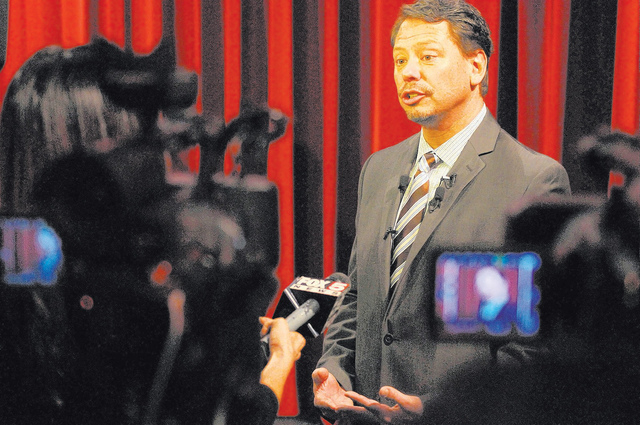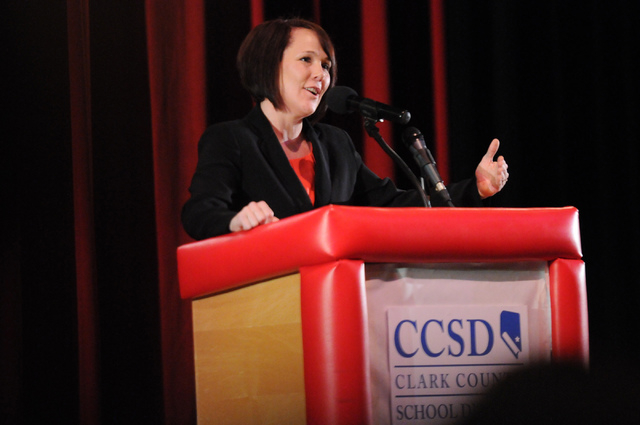CCSD bolsters graduation rate by correcting tracking errors
The graduation rate for Clark County School District, often regarded as one of the lowest-performing urban school systems in the country, has increased for the second consecutive year to 72 percent in 2013, according to information released by the Nevada Department of Education on Monday.
The graduation rate was 62 percent in 2012 and 59 percent in 2011.
However, the impressive 10-percentage-point improvement reported for 2013 comes with a disclaimer. The majority of the graduation rate increase isn’t because of more students graduating, but rather to the district correcting errors in how it tracks students.
The district did graduate 900 more students in 2013 than in 2012, with 16,194 seniors receiving diplomas last year.
“Today’s a day of celebration and appreciation,” district Superintendent Pat Skorkowsky said Monday, sharing the good news in an announcement at Las Vegas High School, but acknowledging it’s a “two-part story.”
The district also saw another dramatic increase, one responsible for 60 percent of the graduation rate improvement. And it isn’t about the class of 2013 doing better than previous classes. It’s because of wrongs being righted at the district’s central office and at the schools.
For the class of 2013, the district said about one in five students — or 5,411 — transferred out of district schools sometime between enrolling in high school as freshmen and graduation. That’s a 56 percent increase, or 1,948 more students reported as transferring out compared with the 3,463 transfers out of the previous senior class.
The district didn’t experience a mass exodus of students between 2012 and 2013. The difference is because of officials making an effort to track departing students, finding out whether they’ve transferred to another school instead of simply labeling them as dropouts, as was often done in the past, Skorkowsky said.
“One thing we haven’t been good about is tracking students,” said Skorkowsky, leader of the nation’s fifth-largest school district, which struggles with student transiency. “We had to make some major changes. From now on, if a student doesn’t show up, we find out where they went.”
Under the direction of its new superintendent in his 10th month on the job, school staffs are calling students’ emergency contacts, finding students on social media sites and even going to homes to find whether teens are in school elsewhere or nowhere at all.
Before 2012-13, the district had no system in place to report outside schools calling for the transcript of a Clark County student. All these transcript requests are now forwarded to one place at district headquarters to make sure these students are counted as transfers out, Skorkowsky said.
It helped at Valley High School, where Principal Deann Burnett said student transiency is high. The school, near Karen and Eastern avenues, graduated 62 more students, but it also found 63 more transfers out. Altogether, that raised Valley’s graduation rate 10 percentage points to 59 percent. She found the problem was sometimes as simple as students being coded as dropouts in the computer system when the school knew they were transfers out.
“It’s a little thing but has a big impact,” she said, arguing that a proper label ensures the school and its teachers get credit for a student who “may not be here but somewhere else doing well.”
‘ONE-TIME BUMP’
These efforts had a dramatic effect on the district’s 2013 graduation rate and the perceived success of its 56 high schools. Scores of students who would’ve been previously identified as dropouts —counted as failures and hurting the graduation rate — are now called transfers out. They are removed from the equation and not counted at all, bolstering Clark County’s student success rate.
Henderson’s Green Valley High School was one of the schools that benefited most from the district’s improved tracking of students. Its graduation rate shot up 14 percentage points to 80 percent in 2013. Green Valley did so by counting 182 transfers out, more than quadruple the 41 transfers out from the class of 2012.
Green Valley is similar to 15 other Clark County high schools, which all graduated fewer students than the previous year but reported more transfers out and increased their graduation rates.
Those high schools are Bonanza, Boulder City, Burk Horizon Southwest, Cimarron-Memorial, Coronado, College of Southern Nevada-East, Del Sol, Desert Pines, Desert Rose, Durango, Las Vegas Academy, Legacy, Palo Verde, Silverado, and Spring Valley.
“It’s a one-time bump,” acknowledged Skorkowsky after announcing the district’s 10-percentage-point graduation rate increase.
He emphasized that the 2013 graduation rate is the first true picture of how the district is doing.
The Clark County School District is responsible for not counting students properly until now, said Judy Osgood, spokeswoman for the Nevada Department of Education. The state’s rules are clear and uniform across Nevada. Transfers out are to not be counted in the graduation rate.
“Those rules should be followed by districts,” said Osgood, while acknowledging that Clark County — with 315,000 students — has a larger challenge than rural districts.
“It’s easy to track students when you have a class of a few hundred,” said Nevada Superintendent of Public Schools Dale Erquiaga.
But the state’s urban districts have a task on their hands, he said. The state told the Washoe County School District, which also had student-tracking errors, and Clark to change how they count students leaving high school and transferring into adult education. The rules on that were previously unclear and districts were counting these students as dropouts when they are actually transfers out.
The state’s graduation rate is 71 percent, up from 63 percent in 2012. Much of that increase is because of Clark County, which has two-thirds of Nevada’s students.
KEEPING SUCCESS IN SIGHT
While Skorkowsky acknowledged past mistakes, he warned against losing sight of the progress made — 900 more seniors with diplomas.
Some schools, like Canyon Springs High School in North Las Vegas, leaped forward without much help from transfers out.
The school’s transfers out were consistent, 112 students in 2013 compared to 106 in 2012. Like Green Valley, Canyon Springs increased its graduation rate by 14 percentage points. Canyon Springs’ graduation rate is now 63 percent.
Ron Guerzon, who became principal of the school in 2012-13 when it was labeled a turnaround because of chronic underperformance, attributes that improvement to a changing culture in the school.
“It’s no longer straight F’s and nobody cares,” said Guerzon, noting how each student is tracked and receives individual attention if they’re failing.
Contact reporter Trevon Milliard at tmilliard@reviewjournal.com or 702-383-0279.


























